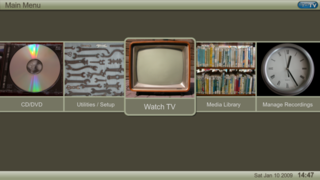
Streaming media is multimedia that is delivered and consumed in a continuous manner from a source, with little or no intermediate storage in network elements. Streaming refers to the delivery method of content, rather than the content itself.
Universal Plug and Play (UPnP) is a set of networking protocols that permits networked devices, such as personal computers, printers, Internet gateways, Wi-Fi access points and mobile devices to seamlessly discover each other's presence on the network and establish functional network services. UPnP is intended primarily for residential networks without enterprise-class devices.
Technological convergence is the tendency for technologies that were originally unrelated to become more closely integrated and even unified as they develop and advance. For example, watches, telephones, television, computers, and social media platforms began as separate and mostly unrelated technologies, but have converged in many ways into an interrelated telecommunication, media, and technology industry.

MythTV is a free and open-source home entertainment application with a simplified "10-foot user interface" design for the living room TV. It turns a computer with the necessary hardware into a network streaming digital video recorder, a digital multimedia home entertainment system, or home theater personal computer. It can be considered a free and open-source alternative to TiVo or Windows Media Center. It runs on various operating systems, primarily Linux, macOS, and FreeBSD.

A home theater PC (HTPC) or media center computer is a convergent device that combines some or all the capabilities of a personal computer with a software application that focuses on video, photo, audio playback, and sometimes video recording functionality. Since the mid-2000s, other types of consumer electronics, including game consoles and dedicated media devices, have crossed over to manage video and music content. The term "media center" also refers to specialized application software designed to run on standard personal computers.

Internet Protocol television (IPTV) is the delivery of television content over Internet Protocol (IP) networks. This is in contrast to delivery through traditional terrestrial, satellite, and cable television formats. Unlike downloaded media, IPTV offers the ability to stream the source media continuously. As a result, a client media player can begin playing the content almost immediately. This is known as streaming media.
Digital Living Network Alliance was founded by a group of PC and consumer electronics companies in June 2003 to develop and promote a set of interoperability guidelines for sharing digital media among multimedia devices under the auspices of a certification standard. DLNA certified devices include smartphones, tablets, PCs, TV sets and storage servers.

An Internet radio device, also called network music player is a hardware device that is capable of receiving and playing streamed media from either Internet radio stations or a home network.
Roku, Inc. is an American publicly traded company based in San Jose, California, that manufactures a variety of digital media players for video streaming. Roku has an advertising business and also licenses its hardware and software to other companies.
The Hauppauge MediaMVP is a network media player. It consists of a hardware unit with remote control, along with software for a Windows PC. Out of the box, it is capable of playing video and audio, displaying pictures, and "tuning in" to Internet radio stations. Alternative software is also available to extend its capabilities. It can be used as a front-end for various PVR projects.

A digital media player is a type of consumer electronics device designed for the storage, playback, or viewing of digital media content. They are typically designed to be integrated into a home cinema configuration, and attached to a television and/or AV receiver.
Monsoon Multimedia was a company that manufactured, developed and sold video streaming and place-shifting devices that allowed consumers to view and control live television on PCs connected to a local (home) network or remotely from a broadband-connected PC or mobile phone. It was one of 5 major transformations initiated by Prabhat Jain, a Silicon Valley entrepreneur with 5 undergraduate and post graduate engineering degrees from Cal Berkeley and Univ of Vienna, Austria. On the even of Cisco acquiring Monsoon in 2017, EchoStar, the new parent of Sling sued Monsoon for patent infringement, having obtained confidential information about the date of the acquisition by Cisco from a Monsoon employee under murky circumstances. Monsoon settled the lawsuit by agreeing not to sell its products in the USA simply because it did not have the legal funds to fight mighty Echostar's legal maneuvers. EchoStar thus successfully removed its only competitor from the market place. This meant Monsoon's death knell.

Netgear's Digital Entertainer line of products are digital media players that can pull multimedia content from home computers to the typical audio/video entertainment center. There are three products in the line, the EVA700, the HD EVA8000 and the current EVA9150 Digital Entertainer Elite. All support high definition video, the EVA700 via component output up to 1080i and the EVA8000/EVA9000 up to 1080p with both component and HDMI connectors. All models support audio, video, image and streaming audio and video formats and can be networked via wired and wireless Ethernet. The EVA700 is Intel Viiv certified.

Boxee was a cross-platform freeware HTPC software application with a 10-foot user interface and social networking features designed for the living-room TV. It enabled its users to view, rate and recommend content to their friends through many social network services and interactive media related features.
PlayOn is a streaming media brand and software suite that enables users to view and record videos from numerous online content providers. The suite consists of two main products: PlayOn Cloud and PlayOn Desktop. PlayOn Cloud is an online service for recording digital video streams, accessible via native iOS or Android mobile device applications. PlayOn Desktop is Windows-based software that acts as a streaming dashboard and hub on the PC. The available streaming websites are organized as channels in both products. Users browse through or search the video content found in those channels in order to record the videos for later viewing. PlayOn Desktop allows watching the videos real-time on the PC, or casting the videos to a TV via a streaming device or gaming console.

RealNetworks, Inc. is a provider of artificial intelligence and computer vision based products. RealNetworks was a pioneer in Internet streaming software and services. They are based in Seattle, Washington, United States. The company also provides subscription-based online entertainment services and mobile entertainment and messaging services.

AirPlay is a proprietary wireless communication protocol stack/suite developed by Apple Inc. that allows streaming between devices of audio, video, device screens, and photos, together with related metadata. Originally implemented only in Apple's software and devices, it was called AirTunes and used for audio only. Apple has since licensed the AirPlay protocol stack as a third-party software component technology to manufacturers that build products compatible with Apple's devices.
Skifta was a media shifting service developed by Qualcomm Atheros. It enabled Android and Apple (IOS) smartphone and tablet users to access their music, pictures, and videos from their phone, from cloud media services or remotely from another location via a smart mobile device. The user could then stream media to connected consumer electronics anywhere that supports DLNA and UPnP standards over WiFi or 3G networks.











